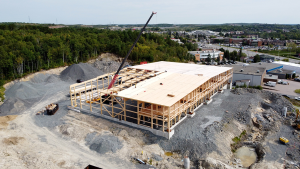Mass Timber Construction (MTC) is touted as construction’s wonder material. It’s sustainable, renewable, light and easy to assemble, and attractive, say its promoters. Life Cycle Analyses (LCA) investigating GHG emissions appear to overwhelmingly favour wood over concrete and steel. Even the recent doubling of wood prices has not dampened enthusiasm for its use in ever-larger construction projects.
Wood is good and many MTC claims are true to a certain degree. However, perhaps it’s time to dial down some of MTC’s exuberant rhetoric.
First, let’s take a look at MTC’s sustainability claims.
Trees and oceans together absorb 50 per cent of global atmospheric carbon. However, once a tree is forested, it can no longer capture carbon — at best it can only store what is already there. Reforestation is critical, of course, however a seedling is a poor substitute for an old growth tree. It will take decades for a seedling to reach the mature height of its predecessor.
In an article published last June in Canada’s National Observer, climate reporter Barry Saxifrage writes, “Death and decay are winning in Canada’s vast managed forest lands. And this victory is unleashing a rising flood of climate pollution. Put simply, our forests are dying and being cut down faster than they can grow back.”
The result, according to the woodland conservation group Wildlands League, is that commercial forestry is creating scars on the landscape that can leave lands barren for 20 to 30 years. This has the collateral effect of disrupting the natural patterns of the area’s entire eco-system. The group also claims there is a high level of wastage with unwanted trees simply left at the side of logging roads.
What’s more, the Pacific Northwest Building Resilience Coalition says harvesting and manufacturing processes negate much of wood’s carbon advantage.
“Of the carbon initially stored in a living tree, only 15 to 30 per cent is transferred to long-lived wood products.”
Of course, not all MTC componentry originates from Canada.
Dominique Briand, general manager of Structure Fusion, told the Daily Commercial News that Europe is often the source of choice for larger laminated beams and slabs. Briand cites the maturity and superior organization of the European market and its many competing laminators that results in “better quality control, reliability and prices.”
However, some LCA studies indicate that transportation by ship, truck and rail from Europe can increase the carbon associated with wood beyond that of many locally-produced concrete mixes.
Even the widely-quoted LCA themselves are being called into question.
“LCA is the right approach, but more data, transparency and robust standards are needed, especially with respect to biogenic carbon,” says the International Institute for Sustainable Development.
“To address embodied GHG emissions in buildings, policy-makers and building professionals need to focus equally on material efficiency and incenting decarbonization across all material manufacturing sectors.”
In other words, LCAs can be unfair to concrete. The Cement Association of Canada claims that current LCA models, “effectively omit up to 72 per cent of a wood product’s carbon footprint, enough to erode wood’s perceived carbon advantage.”
“Conducting whole building life cycle analysis is very complex and there are many variables that can affect the outcome of the analysis,” Christie Gamble, senior director of sustainability of CarbonCure told the Daily Commercial News. “Calculating the carbon footprint of concrete is an example of one such variable that has a wide range of outcomes depending on the assumptions.”
The carbon contribution of wood can vary, just as it can with concrete, explained Gamble. In some cases, carbon inputs associated with MTC can even exceed that of some average mixes of concrete. Unfortunately, LCAs comparing wood to concrete often do not take into account the latest carbon-reducing technologies, like CarbonCure’s carbon capture process.
MTC has a promising future in construction. However, it is unnecessary to promote it by characterizing steel and concrete as construction’s bad guys, and by ignoring those industries’ recent advances towards carbon reduction.
John Bleasby is a Coldwater, Ont.-based freelance writer. Send comments and Inside Innovation column ideas to editor@dailycommercialnews.com.











Recent Comments
comments for this post are closed